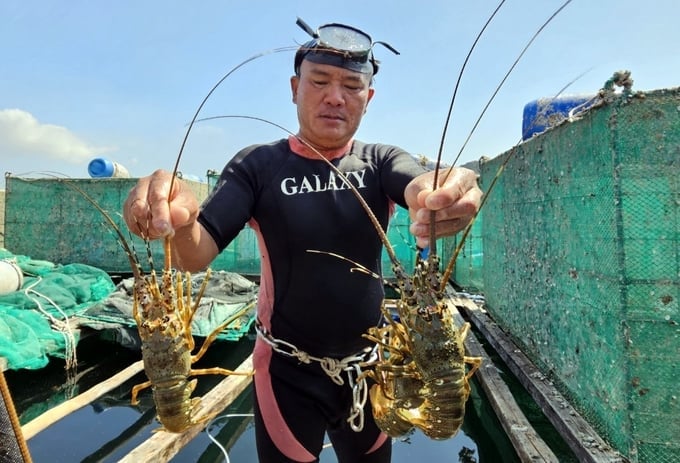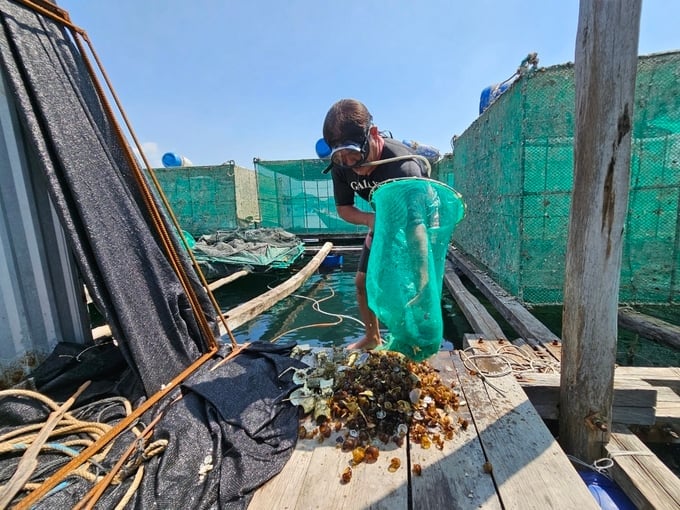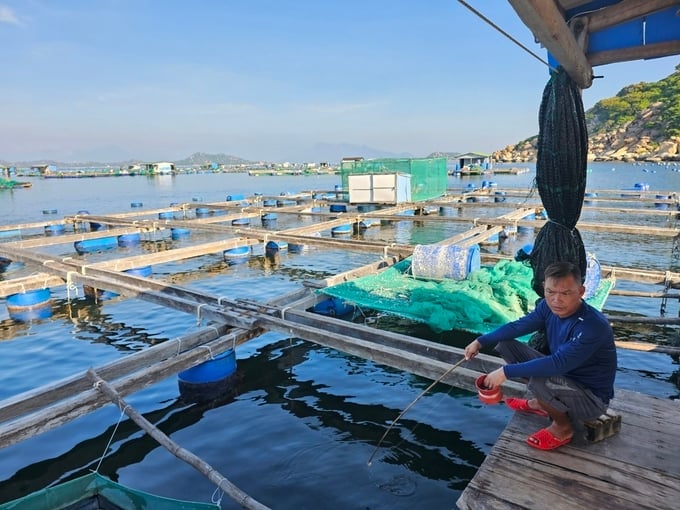June 20, 2025 | 09:53 GMT +7
June 20, 2025 | 09:53 GMT +7
Hotline: 0913.378.918
June 20, 2025 | 09:53 GMT +7
Hotline: 0913.378.918

Lobster farmers expressed their concerns regarding lobster diseases such as Milky Hemolymph disease, red body disease, and black gills. Photo: KS.
Scheduled for November 15, 2023, the Ministry of Agriculture and Rural Development will host the Forum on "State of Breeding Stock, Feed, and Aquaculture Supplies; Tracing Product Origin and Sustainable Development Solutions for Vietnam's Aquaculture" in Nha Trang city, Khanh Hoa province.
Forum Agenda: Management of lobster breeding stock, sustainable lobster farming solutions; Tracing the origin of lobsters and aquaculture products to meet market demands; Control of imported aquaculture breeding stock; Research and production of industrial feed, various supplies for aquaculture; the state of the seafood market at year-end and projected outlook for 2024.
Van Phong Bay in Van Ninh district is one of the key lobster farming areas in Khanh Hoa province with around 35,000 farming cages, which is primarily concentrated in Van Thanh commune. Mr. Tran Minh Hien, head of the lobster farming cooperative in Khai Luong hamlet, Van Thanh commune, Van Ninh district, stated that lobsters are a species in aquaculture affected by significant risks of diseases.
"Milky Hemolymph, red body, and black gills are dangerous diseases that can cause mass deaths of lobsters. If lobsters encounter these diseases, farmers can expect severe economic losses," shared Mr. Tran Minh Hien. Additionally, the recent shortage of water supply, in combination with a lack of safe fresh feed, has lead to substantial mortality rates in farmed lobsters, thereby making them more susceptible to Milky Hemolymph and black gill diseases.

Milky Hemolymph disease as found on lobsters. Photo: KS.
According to Mr. Tran Minh Hien, spiny lobsters are more susceptible to the aforementioned diseases, whereas blue lobsters are less disease-prone. The majority of farmers in the Van Thanh aquaculture area are currently farming spiny lobsters. The aquaculture area has sporadically recorded cases of Milky Hemolymph disease in the past. However, the most prevalent disease on lobsters at present is black gill disease. Notably, the entire farming area experienced a widespread outbreak of black gill disease between July and December 2022, resulting in mass lobster deaths. Additionally, the farmed lobsters suffered from stunted growth, causing significant economic losses for the local farmers.
An exemplary case is Mr. Hien's family, who started the crop with 4,000 lobsters but only 1,500 remained at the time of harvest, leading to nearly 1 billion Vietnamese dong in losses. Similarly, Mr. Nguyen Xuan Hoa, from Van Gia town, Van Ninh district, who farmed lobsters in Van Thanh commune, also incurred severe losses due to the outbreak of black gill disease in 2022. Mr. Nguyen Xuan Hoa reportedly released 7,000 lobsters at the start of the crop, but the lobsters gradually dwindled in numbers until only 1,400 lobsters remained at the time of harvest.
According the farmers, symptoms for the Milky Hemolymph disease include reduced lobster activity, minimal responsiveness to surrounding stimuli, and a decreased or complete loss of appetite. A few days following the infection, segments in the lobster's abdomen will change from a clear white to speckled opaque white, and subsequently an opaque white or yellowish color, before becoming soft and emitting a foul odor. Lobsters typically perish approximately nine to twelve days after contracting Milky Hemolymph disease.

Lobster farmers collecting excess feed during the lobster farming process to protect the water environment and minimize diseases among lobsters. Photo: KS.
According to specialized agencies, Milky Hemolymph disease is caused by a bacteria-like intracellular parasitic microorganism similar to Rickettsia. On the other hand, red body disease is caused by a group of bacteria, particularly the Vibrio alginolyticus bacteria. Lobsters affected by this disease exhibit red discoloration in the region of the cephalothorax or abdominal area. Subsequently, the red color spreads gradually throughout the entire body. The lobsters experience necrosis of the liver and pancreas, joint dislocation in the legs, susceptibility to easy breakage of the antennae, bruised or purple-colored undersides, weakening, loss of appetite, and eventual death.
The black gill disease is caused by the Fusarium sp. fungus, which is one of the factors behind the black gills observed in farmed lobsters. Infected lobsters change their color from an ivory white to a brown or black hue.
In addition to commercially farmed lobsters, juvenile lobsters also suffer significant losses. Accordingly, lobsters purchased for cultivation initially shed their exoskeletons with healthy signs, but they typically perish by the second or third molting stage.
Mr. Nguyen Van Phuong, Vice Chairman of the People's Committee in Van Thanh commune, stated that farmed lobsters primarily suffer from Milky Hemolymph and black gill diseases. Despite provincial specialized agencies providing guidelines for the treatment and prevention of lobster diseases, the majority of farmers tend to treat the diseases based on experiences.
According to Mr. Nguyen Van Phuong, local community members have reported significant losses in lobster farming due to disease outbreaks within the last few years. An average of 1,000 farmed lobsters can reach a loss of 40% to 50% at the time of harvest, with the lowest being 30%. This significantly impacts the economic efficiency of lobster farming, potentially leading to substantial economic losses if the market purchases products at low prices.

Dangerous diseases on lobsters often result in significant losses for lobster farmers. Photo: KS.
Mr. Doan Van Quang, Director of Song Cau Integrated Lobster Service Cooperative in Phu Yen district, emphasizes the importance of disease prevention in lobster farming. He noted that treatments for lobsters affected by Milky Hemolymph or black gill diseases can be challenging and bear significant impact on the livelihoods of the farmers.
According to Mr. Doan Van Quang, the threat of diseases among lobsters, especially Milky Hemolymph and red body diseases, has been consistently present in the Song Cau aquaculture area. Notably, the disease-induced losses for one lobster cage range from 20% to 30%. Regarding treatments for these diseases in lobsters, Mr. Quang reported that each farmer employs their own techniques based on their experience. However, the effectiveness of these treatments varies, with a low success rate.
Animal health agencies have established treatment protocols for Milky Hemolymph and red body diseases in cage-farmed lobsters, in compliance with Appendix V, Circular No. 04/2016/TT-BNNPTNT dated May 10, 2016, issued by the Ministry of Agriculture and Rural Development. The technical solutions for treating Milky Hemolymph and red body diseases in caged lobster farming, proposed by the Research Institute for Aquaculture III, have been recognized by the Ministry of Agriculture and Rural Development. As a result, it is essential for farmers to adhere to these protocols to effectively treat lobsters affected by Milky Hemolymph and red body diseases.
Regarding the prevention of black gill disease, specialized agencies recommend increasing water flow through the cages by frequently cleaning the cages and relocating them to new farming sites in order to avoid localized contamination.

Lobster farming in Cam Ranh bay, Khanh Hoa province. Photo: KS.
On the other hand, farmers need to select suitable rearing locations, ensuring that the cages are not placed too close to the bottom, removing excess feed, and preventing food contamination (using purple medicine). In the case of infected lobsters, farmers are recommended to apply Formalin at a concentration of 100 to 200 ppm for a period of 10 to 15 minutes per day (for two to four days) to treat the disease.
Moreover, it is essential to separate the infected lobsters by placing them in separate containers for treatment to minimize the spread of the disease and simplify the treatment process. The process of handling and treating the infected lobsters must be gentle to avoid causing physical damages. Furthermore, all necessary preparations must be completed before treating the lobsters, to prevent removing lobsters from cages for extended periods of time without immediate treatment.
Translated by Nguyen Hai Long
![Turning wind and rain into action: [9] Digitizing hydrometeorological data in response to climate change](https://t.ex-cdn.com/nongnghiepmoitruong.vn/608w/files/news/2025/06/17/z6704423696987_15fd32ffc26d590d204d520c9dac6786-nongnghiep-165943.jpg)
(VAN) Farmers have begun accessing hydrometeorological applications to adjust their cropping schedules, aiming to ensure productivity and adapt to climate change.
![Turning wind and rain into action: [8] Real-time salinity detection and early warning technology](https://t.ex-cdn.com/nongnghiepmoitruong.vn/608w/files/news/2025/06/17/z6704423696987_15fd32ffc26d590d204d520c9dac6786-nongnghiep-151127.jpg)
(VAN) Thanks to the integration of modern hydrological-hydraulic models, remote sensing technologies, and artificial intelligence, the accuracy of hydrological forecasting has significantly improved.
![Turning wind and rain into action: [7] Early disaster warnings help marine farmers minimize losses](https://t.ex-cdn.com/nongnghiepmoitruong.vn/608w/files/news/2025/06/17/z6704423696987_15fd32ffc26d590d204d520c9dac6786-nongnghiep-142942.jpg)
(VAN) In recent years, thanks to early disaster warnings and forecasting, marine farmers in Khanh Hoa province have been able to reduce risks and losses, thereby improving production efficiency.
![Turning wind and rain into action: [6] ‘Four on-the-spot’ disaster management software](https://t.ex-cdn.com/nongnghiepmoitruong.vn/608w/files/news/2025/06/17/e5a48259d6a262fc3bb3-nongnghiep-183800.jpg)
(VAN) By simply activating the scenario on the disaster management software, the relevant authorities immediately know how many households need to be evacuated, where to evacuate them to, and by what means of transportation…
![Turning wind and rain into action: [5] Hue applies modern technology in disaster forecasting](https://t.ex-cdn.com/nongnghiepmoitruong.vn/608w/files/news/2025/06/17/z6704423696987_15fd32ffc26d590d204d520c9dac6786-nongnghiep-093938.jpg)
(VAN) In Hue city, modern technology has recently been applied in meteorological and hydrological forecasting and warning, helping to reduce the damage caused by natural disasters.

(VAN) A cutting-edge farming technique being implemented on an experimental ranch in Arizona's Sonoran Desert has already saved a billion gallons of water over five years, according to Civil Eats.

(VAN) Poultry and pig production and the environment can be boosted through enhanced water technology, according to new research.